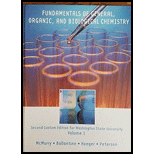
(a)
Interpretation:
The increasing order of the melting point of the element should be identified.
Concept Introduction:
The atomic radius of a chemical element is a measure of the size of its atoms, the atomic radius is distance from the centre of the nucleus to the boundary of the surrounding cloud of electrons.
The atomic radius decreases from left side to right side in the periodic table whereas atomic radius increases from top to bottom in the periodic table.
When size of the atom increases the melting point is degreases, therefore the melting point is decreases from top to bottom of 1 and 2 metals groups.
Generally the melting point of the alkali metals decreases down the group. This is because as the ions get larger the distance between the bonding electrons and the positive nucleus gets larger and reduces the overall attraction between the two. For similar reasons the electronegativity decreases.
The melting point of the alkali metals decreases down the group, because the distance between the bonding electrons and the positive nucleus is larger.
(b)
Interpretation:
The increasing atomic radius of the element should be identified.
Concept introduction:
The atomic radius of a chemical element is a measure of the size of its atoms, the atomic radius is distance from the centre of the nucleus to the boundary of the surrounding cloud of electrons.
The atomic radius decreases from left side to right side in the periodic table whereas atomic radius increases from top to bottom in the periodic table.
When size of the atom increases the melting point is degreases, therefore the melting point is decreases from top to bottom of 1 and 2 metals groups.
Generally the melting point of the alkali metals decreases down the group. This is because as the ions get larger the distance between the bonding electrons and the positive nucleus gets larger and reduces the overall attraction between the two. For similar reasons the electronegativity decreases.
The melting point of the alkali metals decreases down the group, because the distance between the bonding electrons and the positive nucleus is larger.
(c)
Interpretation:
The increasing atomic radius of the element should be identified.
Concept introduction:
The atomic radius of a chemical element is a measure of the size of its atoms, the atomic radius is distance from the centre of the nucleus to the boundary of the surrounding cloud of electrons.
The atomic radius decreases from left side to right side in the periodic table whereas atomic radius increases from top to bottom in the periodic table.
When size of the atom increases the melting point is degreases, therefore the melting point is decreases from top to bottom of 1 and 2 metals groups.
Generally the melting point of the alkali metals decreases down the group. This is because as the ions get larger the distance between the bonding electrons and the positive nucleus gets larger and reduces the overall attraction between the two. For similar reasons the electronegativity decreases.
The melting point of the alkali metals decreases down the group, because the distance between the bonding electrons and the positive nucleus is larger.
Want to see the full answer?
Check out a sample textbook solution
Chapter 2 Solutions
Fundamentals Of General, Organic, And Biological Chemistry Volume 1 Second Custom Edition For Washington State University, 2/e
- How many grams of NaCl are required to prepare 100 mL of a solution of 1 M NaCl? (NaCl molecular weight = 58.44 g/mol)arrow_forwardAssume that you have a stock solution of 10% SDS and you need to make 150 microliters of 0.5% SDS. What volume of 10% SDS and what volume of water would you use?arrow_forwardHow many grams of copper sulfate would you need to make 5 L of a 7 M copper sulfate solution?arrow_forward
- For each of the following reactions, give a balanced net-ionic equation. Sulfate Ion a) MgSO4 + H2SO4 b) MgSO4 + BaCl2 Sulfite Ion a) Na2SO3 + H2SO4 b) Na2SO3 + BaCl2 c) BaSO3 + HNO3 Iodide Ion a) NaI + NaOCl b) NaI + AgNO3 c) AgI + NH3 d) NaI + H2SO4arrow_forward12 grams of glucose will make how many mL of a 0.5 g/mL solution?arrow_forwardIf I put 80g of NaOH in 0.5L of H2O, what is the molar out of solution?arrow_forward
- What is not valid for aerosols?arrow_forward(i) MnO is basic whereas Mn207 is acidic in nature. Why? (ii) Transition metals form alloys. Why? (iii) Complete the following equation: 2MnO4 + 4KOH + O2 ———>arrow_forwardAssuming equal concentrations of conjugate base and acid, which one of the following mixtures is suitable for making a buffer solution with an optimum pH of 7.4–7.6? NaOCl / HOCl (K a = 3.2 × 10 –8) NH 3 / NH 4Cl (K a = 5.6 × 10 –10) NaNO 2 / HNO 2 (K a = 4.5 × 10 –4) NaCl / HCl CH 3COONa / CH 3COOH (K a = 1.8 × 10 –5)arrow_forward
 Biology (MindTap Course List)BiologyISBN:9781337392938Author:Eldra Solomon, Charles Martin, Diana W. Martin, Linda R. BergPublisher:Cengage Learning
Biology (MindTap Course List)BiologyISBN:9781337392938Author:Eldra Solomon, Charles Martin, Diana W. Martin, Linda R. BergPublisher:Cengage Learning
